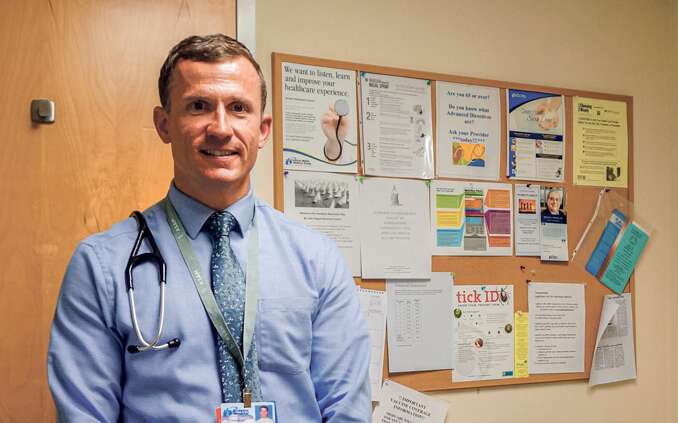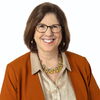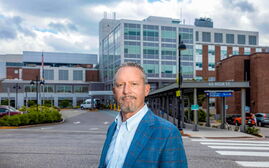
Prescription for Maine’s health: It’s all about access
 Photo / Jim Neuger
Jeff Walawender, executive director and chief dental officer at Community Dental, cites oral health issues among Maine’s biggest health care challenges.
Photo / Jim Neuger
Jeff Walawender, executive director and chief dental officer at Community Dental, cites oral health issues among Maine’s biggest health care challenges.
Before some of the biggest issues affecting health in Maine can be attacked, providers have to figure out how residents in rural underserved areas, or even those in urban areas but lacking insurance and money, can be connected with services. Some providers are finding innovative ways to do just that. Here are two of their stories.
Technology, collaboration bring dental care to Monson
Construction is underway in Monson, in central Piscataquis County, for a dental clinic that will address a vital health care gap in the state’s least-populous county.
Falmouth-based Community Dental will run the clinic as part of a health care collaboration with Northern Light Health and the Libra Foundation. The clinic, being built in the former elementary school on Greenville Road, which has housed the arts center for the past few years, will also include optometry and primary health care. The arts center is moving to 8 Greenville Road, in the heart of downtown Monson. The clinic is expected to open in November.
As revitalization takes hold in Monson, spurred by $10 million in investment by the Libra Foundation, “A key factor [that’s an obstacle to a sustainable economy] is how difficult it is to access dental care,” says Peter Bates, former chief medical officer at MaineHealth, who consulted on the project.
Two other issues addressed by the health center will be optometry, which will be provided at the health center by Waterville-based Eye Care of Maine, and a primary care clinic by Northern Light C.A. Deane Hospital of Greenville. All three will operate out of the clinic a couple days a week and share some administrative staff.
Profound effects
The lack of access to health care, and specifically dental care, has a profound impact on a person’s physical and mental health, those behind the clinic say.
When someone has dental issues that aren’t treated, “Life has changed, and not for the better,” Bates says.
Jeff Walawender, Community Dental executive director and chief dental officer, agrees.
“I see it every day,” he says. “For people living below the poverty level, oral health disease is not only devastating but tremendously expensive, and not just for the patient, but for the system, too.”
Poor dental care has been associated with cardiovascular disease. But he adds that issues like replacement of missing teeth can not only affect a person’s physical health, but their mental health.
“It’s devastating to self-worth,” he says. “I see people hanging onto teeth that are infected in order to maintain their physical appearance not only for their self-esteem but also to aid in employment opportunities. It’s heartbreaking and not a position anyone should be placed in.”
The dental model at the Monson clinic will keep costs down while providing needed services, he says. Community Dental also has clinics in Portland, Biddeford, Lewiston, Rumford and Farmington.
“Monson’s not a large town, and it’s not in a populated area,” Walawender says. Traditionally, dental practices need 1,500 to 2,500 active patients per full-time dentist. Because Community Dental treats many patients who are on Medicaid, which only covers urgent dental care for adults, those numbers need to be even higher because patients visit less consistently.
The biggest challenges to dental care access in Maine are cost and geography, Walawender says.
It’s about the numbers
Monson, with about 700 residents, is in Maine’s least populous county, Piscataquis, with 17,000 people. While there are some health care providers in the area, the closest large service center is Bangor, 60 miles away.
“The issue is to set up a clinic with the number of patients needed,” he says. “And then, to actually get providers into clinics long-term if they’re not from that geographic location.” He says that it’s difficult to fully staff the organization’s locations in more populous areas, and recruiting for the remote areas can often take up to a year.
The dental clinic will be primarily staffed by an independent practice hygienist, who in Maine can take radiographs, perform cleanings, apply fluoride and place temporary restorations without direct supervision of a dentist. He says the independent practice hygienist, who will work closely with Community Dental’s dentists and staff, is key to the project.
The clinic will use teledentistry to remotely review the hygienists radiographs, photographs and notes to develop treatment plans and schedule dentists within their own network to provide care at the Monson center.
Craig Denekas, CEO of the Libra Foundation, says the former elementary school is a good fit for the health clinic. It already conforms to Americans with Disabilities Act standards, is on one floor, and has plenty of parking and space.
“When you look at the basic fabric of any community, it’s schools and hospitals,” Denekas says.
The town’s library has also moved to the building, making it a community center. “And it brings more people into town,” he says.
Part of the Libra Foundation’s goal as it bought and renovated buildings in town, and created the Monson Arts residency and arts program, was to provide meaningful industry, Denekas says. He and Bates both say the clinic not only provides a needed service, but also an economic and jobs boost.
“It’s not only about access to health care,” Bates says.
Bates, now vice dean at Tufts Medical Center in Massachusetts, says the Monson model is one that could be used to address similar issues in other parts of the state. “Monson is a little unique, but it’s scalable.”
Inroads to access
Community Dental has made inroads to access in areas that aren’t just dictated by geography. The organization runs a free Thursday afternoon clinic at the Learning Collaborative in Portland’s Preble Street neighborhood in partnership with MaineHealth and Preble Street Resource Center to reach some of the most vulnerable and underserved populations.
Many of the collaborative’s patients weren’t receiving dental care and have a bad diet, which contributes to poor oral health.
People living in poverty or with addiction issues “often eat food and drinks that are bad for their teeth,” Walawender says. Sugary food is a major contributor to cavities, “even for people who brush their teeth.”
Community Dental has also expanded service in its Portland center to include sedation services, orthodontics and root canals. They found that when they referred their patients to a specialist’s office the no-show rate was around 50%. Once they started providing some of the services within their clinics, it dropped to 10% to 15%.
Overall, Community Dental has 17,000 patients and 42,000 visits a year.
Walawender says the organization hopes that nonprofit dental care providers in the state can form a consortium of clinics that can tackle some of the state’s oral health issues, and help create a comprehensive dental care benefit to low-income adults that provides more than just emergency coverage. “The hope is we can work together, and get a better support network to care for the oral health needs of the state.”
Access is turning tide on opioid crisis
While Maine’s opioid addiction crisis may seem insurmountable — nearly 1,700 residents have died of overdoses in the past five years, according to state officials — those who treat addiction say more access to care may be turning the tide.
“We are in the midst of the most devastating health crisis we’ve ever seen,” says Peter Leighton, a primary care physician with Central Maine Healthcare’s Bridgton Primary Care. “Mainers are dying every day.
“Access is the biggest barrier,” Leighton adds. “But it’s turning around.”

When Gov. Janet Mills signed an order Jan. 3 allowing Medicare expansion in the state, giving access to health care for 70,000 more Mainers, for a total of more than 250,000, that was a big start, says Leighton, a primary care physician who solely treats those with addiction. “We’re trying to get patients with opioid use disorders on MaineCare. That’s the golden ticket.”
The next step — access to buprenorphine, the synthetic drug used to treat opioid use disorder — is tougher. Federal law requires physicians to get a waiver to prescribe the drug for out-patient use. It can also be administered in a three-day dose in an emergency room as well as in in-patient treatment.
Physicians are required to attend an eight-hour program to get the waiver. Of Maine’s nearly 4,200 practicing physicians, 788 are certified to prescribe buprenorphine, according to the Substance Abuse and Mental Health Services Administration.
It’s saving lives
While counseling and other measures are important in treating addiction, Leighton says, “Buprenorphine is what is saving lives. Getting rid of that waiver is the biggest thing in improving access to treatment.”
The Pew Research Center reported in February that rural areas are hit harder by opioid-related deaths, largely because of lack of access to treatment. Between 1999 and 2015, overdose deaths increased 325 percent in rural counties in the U.S., and in 2015, rural deaths surpassed the death rate in urban areas. Office-based treatment with medication like buprenorphine is limited — 29.8% of rural Americans live in a county without a buprenorphine provider, compared with 2.2% of urban Americans, Pew found.
While some are working on the federal level to eliminate the waiver, health care systems in Maine are finding ways to work with it and increase access.
New plan for access
In February, Mills created a director of opioid response cabinet position, a position held by Gordon Smith. Training up to 250 recovery coaches, who would work with emergency rooms, as well as finding ways for emergency rooms in general to increase access to buprenorphine treatment, were among the goals listed in her executive order.
Central Maine Healthcare this year instituted a bridge program, headed by Dr. Paul Vinsel, in which a patient who gets a three-day emergency room prescription can get an additional three-day one from a doctor with a waiver, giving the patient time to connect with Leighton or another CMH doctor who can begin a treatment plan.
In Bridgton, the program works with the Lakes Region Recovery Center, created last year on the hospital’s campus.
Mid-Coast Hospital in Brunswick, last year, was the first to institute a program that began long-term treatment with buprenorphine in the ER. In announcing the program, the hospital cited a 2015 study by Yale University that found early intervention by a team of emergency department physicians and behavioral health providers can result in better outcomes for people with an opioid addiction.
Leah Bauer, a physician with the Mid Coast Hospital Addiction Resource Center, said at the time, “Medications stop withdrawal and relieve cravings so patients can have the best chance of engaging in successful treatment.”
Several hospitals, including Portland’s Mercy Hospital, now have emergency room access programs.
In April, Penobscot Community Health Care, in Bangor, announced that it will offer walk-in access at its Union Street clinic to patients who need treatment, and then will connect with a treatment program for further care.
Getting beyond the stigma
Leighton, a Sebago native, graduated from residency in 2006, and in 2013 became a primary care doctor. He practices out of Bridgton Primary Care.
He got a waiver to prescribe buprenorphine in 2013. “I built up a little side practice in addiction medicine,” he says. He soon realized the need was overwhelming, and in 2016 he began treating addiction patients full-time.
He says while action by the Mills administration is helping increase access to care, there is another big barrier to get past — the stigma associated with addiction.
“We come from Puritan stock,” he says. “Alcoholism and addiction in general are very, very taboo. The number one barrier to treatment is the stigma.” He says that includes in emergency rooms and among the medical profession.
He says that the focus on better access is beginning to turn that around, too. “There’s a realization that these are patients who need help,” he says.
He sees a day when addiction will be treated by a primary care physician, just like any other disease. “We’re going to treat diabetes, hypertension, COPD, asthma and addiction the same,” he says. “It’s a chronic disease, so we need to use a chronic disease model, and that starts with access.”














0 Comments